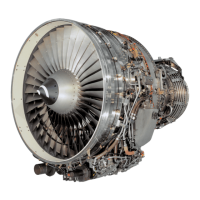EFFECTIVITY
ALL CFM56 ENGINES
CFMI PROPRIETARY INFORMATION
CFM56-ALL TRAINING MANUAL
HIGH PRESSURE
TURBINE
BORESCOPE
INSPECTION
Page 140
Sep 03
HIGH PRESSURE TURBINE (HPT)
(ALL) :
HPT rotor damage may occur after engine abnormal
operation.
The following list provides examples of the conditions
where a complete inspection should be performed :
- Core stall (N2).
- Overtemperature.
- Metal in the tailpipe.
- N2 overspeed, abnormal core vibrations, hard
landing.
Rotor inspection areas.
Rotor blades are internally cooled by CDP air which
enters through the blade root and exits through several
rows of holes and a series of trailing edge slots.
To help you estimate the HPT blade wear, 2 of the blades
(-2, -3, -5A, -7B) or 4 of the blades (-5C) have 3 tip wear
notches 0.010, 0.020 and 0.030 inch. They are located
180° apart (-2, -3, -5A, -7B) or 90° apart (-5C) around the
rotor.
A missing notch does not necessarily mean the part is
not serviceable.
(ALL) :
Individual replaceable shroud segments face the blade
tips and are cooled with CDP air.
They can be checked during inspection of the HPT rotor
leading edge and nozzle guide vane trailing edge.
The inspection areas of the HPT are as follows:
1- Blades:
- Leading edge.
- Trailing edge.
- Thermal barrier coating.
- Nose holes.
- Gill holes.
- Trailing edge slots.
- Concave surfaces.
- Convex surface.
- Wear notches.
- Platforms.
2- HPT shrouds.

